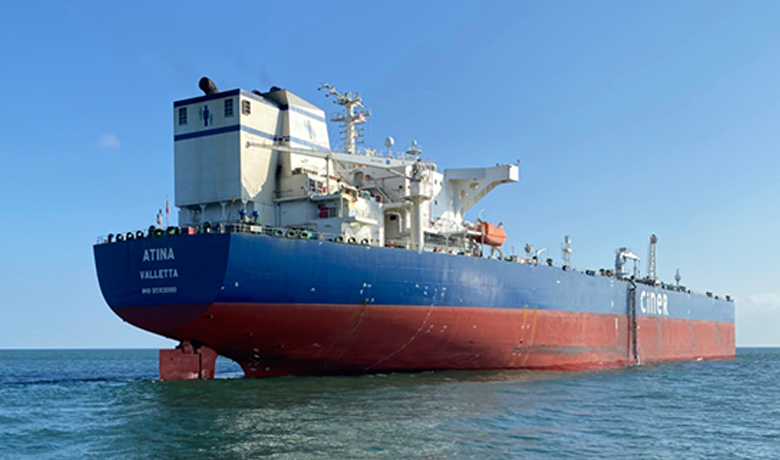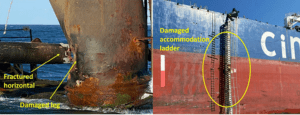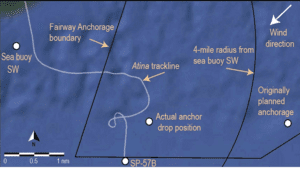

The master aboard a Malta-flagged tanker hadn’t slept in more than 50 hours when his ship collided with an oil rig in the Gulf of Mexico near Southwest Pass, federal investigators said.
The 898-foot Atina hit the manned oil and gas platform SP-57B at 0446 on Oct. 17, 2020 while anchoring in strong winds, the National Transportation Safety Board (NTSB) said. The master boarded the ship about 3.5 hours earlier after flying from his native Turkey.
SP-57B required nearly $73 million in repairs, but there was no pollution stemming from the incident. The five people on the platform escaped without injury.

“The master was placed into critical vessel evolutions — navigating downriver and anchoring at night — in a fatigued state due to the company’s decision to change out vessel masters without any overlap,” the NTSB said in its report.
“An overlap,” the NTSB continued, “would have allowed for the incoming master to rest and receive his counterpart’s handover information. This change out did not follow the procedures set out in the company’s (safety management system).”
Atina discharged its crude oil cargo at a riverside terminal upriver from New Orleans. From there, it was 166 miles to its destination at the Southwest Pass Fairway Anchorage in the Gulf of Mexico, some 21 nautical miles from Pilottown, La.
The relief master boarded the ship at 0110 as the vessel was outbound about 13 miles north of Pilottown. This was his first time aboard Atina, the report said. The relief master passed the outgoing master on deck with little or no discussion about the ship or its voyage plan.
The Associated Branch pilot conning the ship down the Lower Mississippi departed at about 0345 when it reached the sea buoy “SW.” The pilot warned the master that the 25-knot winds were causing a strong southwesterly set.
The master admitted to investigators he wanted to anchor as soon as possible after the pilot left so he could sleep. The ship began anchoring at about 0403 in a different part of the Southwest Pass anchorage area than was specified in the voyage plan. The ship was roughly 3,500 feet from the oil rig SP-57B.
Roughly 10 minutes later, the captain inquired about a radar target roughly 3,000 feet away that likely was SP-57B. The second mate mistook the captain’s inquiry for an OSV operating near the oil rig.
Around that same time, the Associated Branch pilot asked about the ship’s position over radio. He warned the master repeatedly to move at least 4 miles from the sea buoy. At that point the ship was about 2.3 miles from it.
“There is no sleep for me, it has been three days straight,” the master lamented at 0420, the report said, before ordering the anchor heaved.
The master ordered the rudder to starboard about 10 minutes later when the bosun on deck reported the anchor chain was grinding against the hull. The master again checked on the radar contact without recognizing it as a stationary platform.
“That is not a ship, it is a platform,” he said at about 0442. Four minutes later, he recognized that a collision was imminent. Atina’s starboard side hit the rig’s northern side at 3.8 knots.
The platform sustained extensive structural damage above and below the waterline, including a fractured leg. Its crew performed emergency shutdown procedures before leaving the platform on a helicopter. Atina sustained hull indents and other damage that required about $600,000 in repairs.
Federal investigators believe the bridge crew lost track of the platform while the crew heaved the anchor. The ship’s S-band radar was set to a scale of 3 miles, making the platform hard to identify amid radar clutter. It was visible on the X-band radar set to a scale of 1.5 miles.
Based on the communication between the master and second mate, the NTSB believed the master mistook SP-57B for a moving vessel until it was too late to avoid a collision.
Separately, the NTSB found the master did not adequately account for the 25-knot wind from the northeast, or the westerly current.
“Likely preoccupied with bringing the anchor in clear from the hull, the master ordered hard starboard rudder while the platform was on Atina’s starboard quarter and with the wind coming from dead ahead,” the report said.
“By doing so, he ended up pivoting Atina toward SP-57B and putting the wind and current on the Atina’s port side, which caused the vessel to set toward the platform,” it continued.
Based on the master’s fatigue, the NTSB concluded he was likely suffering from acute fatigue — which can occur when someone gets less than four hours of sleep in a 24-hour period. As such, he lost situational awareness during the nighttime anchoring evolution.
Atina was owned by Hanzhou 1 Ltd. and operated by the Besiktas Group at the time. The operator’s safety management system (SMS) required at least one day of overlap between a master and his relief. That did not happen in this case, which contributed to the master’s fatigue.
The operating company knew of the travel arrangements between the relief master and the departing master, and that it impossible to meet the one-day requirement in the SMS.
Attempts to reach the ship’s operator and owner for comment on the NTSB report were not successful.
